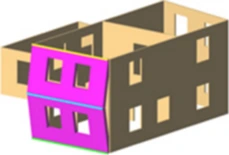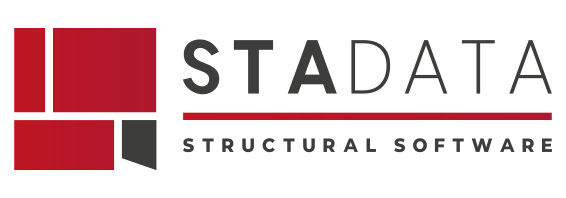List of additional modules
Alongside the main module, which is dedicated to the global verification of the structure, the following optional modules are available to supplement the software. This allows the purchase of only the features that are really needed, optimizing costs, while still allowing 3Muri to be integrated at any time. The additional modules available for the 3muri software are:
In addition to the main module, dedicated to the global verification of the structure, the following optional modules are available to expand the software.
In this way, it is possible to purchase only the functionalities that are really needed, with an effective costs optimization.
At the same time, you can expand 3Muri Project with new modules at any time.
The additional modules available for 3Muri Project software are:
Local Mechanisms
If box-like behaviour is not guaranteed, due to the lack of connections between floors and walls, the verification of local mechanisms is required: i.e. checking for possible detachment of walls out of the plane.
The Local Mechanisms module allows this verification by using the model employed for the global verification (carried out with the main module).
Having completed the model with the geometric data, loads and constraints, the software has all the necessary elements to carry out the local verifications , leaving the designer with only the task of indicating the affected areas.
For more information, read the brochure and watch the video presentation.
If box-like behavior is not guaranteed, due to the lack of connections between floors and walls, the verification of local mechanisms is required: i.e. checking for possible detachment of walls out of the plane.
The Local Mechanisms module allows this verification by using the model employed for the global verification (carried out with the main module).
Once the model has been completed with the geometric data, loads and constraints, the software has all the necessary elements to carry out the local verifications. The designer will only have the task of indicating the zones concerned.
For more information, read the brochure


Sensitivity analysis
The calculation of existing masonry structures is particularly complex due to the uncertainties of the entities involved, such as element stiffnesses, strengths, geometries.
The problem is to quantify this uncertainty which, although impossible to assess in absolute terms, can be measured in relative terms, i.e. through the weight of each individual variable in relation to the others.
For example, if the collapse is determined by the low stiffness of the floors, it is pointless to carry out in-depth investigations on the masonry, after having verified that its incidence is insignificant.
The objective of sensitivity analysis is to provide a better understanding of structural behavior, by identifying the parameters that have the greatest impact on the calculation.
The main advantages for the designer are: the identification of the most probable causes that lead to the collapse mechanisms of the structure, more reliable results, investigations and targeted interventions on the most significant parts, reduction of investigation costs and interventions for adaptation or improvement.
The first step in sensitivity analysis is the identification of groups of parameters that the designer wants to analyze.
Each group of parameters relates to a structural characteristic (for example: vaults, floors, concrete, steel) and is made up of a set of data that can vary within a given range.
Subsequently, numerous non-linear analyses are performed automatically, highlighting the importance of the individual structural characteristics in the overall behavior of the building.
A final statistical evaluation allows to obtain values that are most likely to be reliable.
For more information, read the brochure.
The calculation of existing masonry structures is particularly complex due to the uncertainties of the entities involved, such as element stiffnesses, strengths, geometries.
The problem is to quantify this uncertainty, which although impossible to assess in absolute terms, is measurable in relative terms, i.e. through the weight of each individual variable in relation to the others.
For example, if the collapse is caused by poor slab stiffness, it is pointless to carry out in-depth investigations of the masonry.
The sensitivity analysis aims to gain a better understanding of structural behaviour by identifying the parameters that have the greatest influence on the calculation.
The advantages for the designer are the identification of the most probable causes that determine the collapse mechanisms of the structure, more reliable results, targeted investigations and interventions on the really significant parts, reduction of investigation costs and interventions for adaptation or improvement. The first step in sensitivity analysis is the identification of groups of parameters to be analysed.
Each group of parameters relates to a structural characteristic (e.g. vaults, floors, concrete, steel), and consists of a set of data that can vary within a given range.
Subsequently, numerous non-linear analyses are performed automatically to highlight the importance of individual structural features in the overall behaviour of the building. A final statistical treatment results in values that are most likely to be reliable.
For more information, read the brochure and watch the video presentation.


Foundations
To complete the verifications of elevated structures, 3Muri allows the verification of foundation structures by examining the distribution of stresses in the soil. The Foundations module also allows the examination of the bearing capacity and settlement of continuous foundations and the design of reinforced concrete foundation plinths.
For more complex analyses, in the case of retaining walls against the ground, bulkheads and piles, it is possible to automatically create a model to be analysed with Axis VM, exploiting the full potential of linear and non-linear finite element calculations.
For more information, read the brochure.


Multithreading and sparse matrices solver
The multithreading and sparse matrices module allows the use of two different calculation settings with regard to the processor: the selection of dense matrices or sparse matrices calculation methods and the multiprocessor.
Performing operations using the sparse matrices calculation method can lead to a significant reduction in calculation time and to a lower memory usage, due to the compressibility of the sparse data.
The multithreading module allows each analysis to be directed to a different processor on the PC, with great time saving.
For more information, read the brochure.
The multithreading and sparse matrix module allows the use of two different calculation settings with regard to the processor: the selection of the dense matrix or sparse matrix calculation method and the multiprocessor.
Carrying out operations using the sparse matrix method of calculation can, due to the compressibility of the sparse data, lead to significantly lower memory usage and reduced calculation time.
The multithreading module allows each analysis to be directed to a different processor on the PC, which saves a lot of time.
For more information, read the brochure.

IFC Module
The IFC module allows import and export in IFC format, to enable interoperability between different designers.
IFC Import
3Muri Project allows interoperability with BIM technology through the IFC (Industry Foundation Classes) format, whose specifications are based on a neutral data format specifically designed to describe, exchange and share design information.
3Muri Project provides the import of geometries from IFC models using the BIM Inside application, which is included in the module. In this way, the geometries of the objects can be used for the construction of the model.
IFC export
Once the creation of the model is finished, the direct export of the entire model in IFC format is possible.
This file contains the structural objects defined in the model, with the IFC standard, that can be read by other software, such as Revit®, Allplan®, Archicad®.
For more information, read the brochure.
The IFC module allows import and export in IFC format, to enable interoperability between different designers.
IFC Import
3Muri allows interoperability with the BIM methodology through the IFC (Industry Foundation Classes) format, the specifications of which are based on a neutral data format specifically designed to describe, exchange and share project information.
3Muri provides the import of geometries from IFC models using the BIM Inside application, which is included in the module. In this way, the geometries of the objects can be used for the construction of the model.
IFC export
At the end of modelling, direct export of the entire model in IFC format is possible.
This file contains the structural objects defined in the model that can be read by other software such as Revit®, Allplan®, Archicad®.
For more information, read the brochure and watch the video presentation.

Sismotest
The SismoTest module is the 3Muri module dedicated to the Seismic Classification of Buildings, according to the Italian Ministerial Decree No. 65 of 7/3/2017.
The module implements the requirements of the Guidelines, making them easily applicable, providing suggestions in the evaluation phases and producing the required documents.
For more information visit Sismotest.




